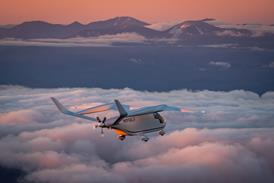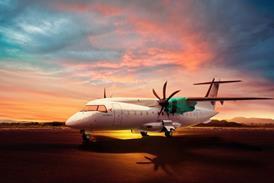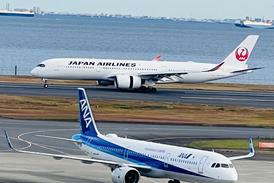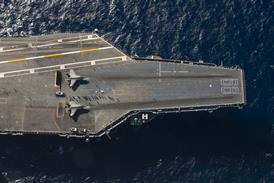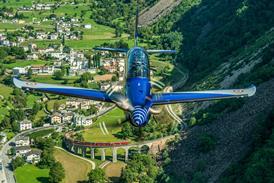France has been in the aero-engine business as long as aircraft have been flying, and today the industry remains present in virtually every area of propulsion activity. The two principal companies, state-owned Snecma and privately owned Turboméca, provide power for civil and military aircraft, helicopters and space - the latter area, through Snecma subsidiary Société Européene de Propulsion, providing some of the most exiting potential for development.
Snecma is divided into three areas - propulsion, mechanical equipment and services, and its fortunes are, at last, improving in all three following a 25% drop in group sales during the four years of aerospace industry recession. The engine business, accounting for almost half of group sales, accounted for by far the biggest fall, amounting to no less than 40% between 1991-5. As a result, a major restructuring programme was implemented which, according to Snecma president Jean-Paul Béchat, is now beginning to bear fruit, with the 4% rise in sales in 1996 expected to turn into a 20% growth this year as the recovery in civil-engine orders begins to feed through.
After a somewhat turbulent period with its long-standing US partner, General Electric, relations are once again back on track, assisted by the phenomenal success of the CFM International (CFMI) alliance, in which both companies have a 50% share. The CFM56 turbofan powers the Airbus A320 family, Airbus A340, Boeing 737-300 family and the new generation of Boeing 737s. In 1996, CFMI won orders for 1,280 engines, giving it an estimated 61% of the global market for powerplants in the 100kN-150kN (22,500-33,700lb)-range. As a result, production of the CFM56 is to be increased from just 443 units in 1996 to 750 in 1997, and 920 in 1998. To cap the success, tests of the new CFM56-7, powering the latest 737s, have shown that the engine will meet all performance goals. This powerplant will almost certainly take sales of the CFM56 range - already the most successful commercial engine in history - to beyond the 3,000-engine mark.
Snecma's relations with GE hit a low mainly because of differences of opinion over the leadership of the GEXX engine which was planned for the A340-500/600 versions of the current A340-300. This led to an agreement between GE and Airbus to study development of an exclusive engine for the aircraft, now abandoned, with the result that Airbus is now talking to Rolls-Royce and Pratt &Whitney about derivative versions of their engines.
The appointment of Jean-Paul Béchat as president has seen a distinct improvement in the atmosphere with GE, with agreement to share development of the 445kN version of the GE90 for growth versions of the Boeing 777. Another major hope for the company, as a participant in the proposed all-new GE/Pratt &Whitney GP7000, disappeared with the cancellation of the aircraft it was to power - the Boeing 747-500/600X (a working group remains to study the Airbus A3XX application).
A further important alliance, forged during the period of poor relations with GE, is with P&W Canada to develop the 62kN SPW14 powerplant for future regional jets, in particular the AI(R) 70-seater Airjet. This is likely to lead to a range of engines which should secure Snecma's position in a thrust range from which it has been absent for many years.
Military business continues to suffer from national-budget cuts, accounting for less than 27% of turnover in 1996, with the possibility of a further drop, to 20%, in 1997. Hopes centre on the long-term prospects for the Rafale Ìghter, which is powered by a pair of 75kN Snecma M88s. Development continues, as does production of the M53-P2 for the 60 Mirage 2000s now being delivered to Taiwan. There was also an order in 1996 for Snecma/Turboméca Larzac engines for the initial batch of ten development Mikoyan MiG-ATtrainers. "This shows our willingness to be present wherever business opportunities arise," says Béchat. Snecma is also ready for the launch of the Future Large Aircraft transport with a deal bringing together MTU, Spain's ITP and Italy's Fiat to develop a large turboprop based on the M88 core. "We hope to be able to make an offer during 1997,"he says.
To ensure long-term stability for its balance sheet, Snecma has ensured that it is moving forward in other areas. It has now completed the takeover of rocket engine and advanced materials manufacturer SEP, which has become a wholly-owned group subsidiary. SEP, in turn, has assumed all of Snecma's former aircraft brakes subsidiary, Messier-Bugatti, creating at a stroke what is claimed to be Europe's largest aviation and automobile braking enterprise. This will incorporate the activities of former SEP subsidiary Carbone Industries, which already supplies the advanced carbon-carbon materials for a new range of brakes being developed by Messier-Bugatti for future Airbus aircraft.
All this represented an abrupt reversal of the previous strategy, in which Snecma was to rid itself of both SEP and Messier-Bugatti. Now, having consolidated its hold on the latter, Snecma holds stakes in CFMI(50%), Messier-Dowty (50%: landing gear), Hispano-Suiza (100%: thrust reversers and nacelles), Techspace Aero (51%: Belgium's engine manufacturer) and Sochata (100%: repair and overhaul). It has also formed, through Sochata, a new enterprise, Snecma Services, to take advantage of the huge - and still growing - market for CFM56 maintenance and support. Béchat has thus made it clear that diversification, and not reliance on the government-sponsored military business which was once such a lifeline, is the only way forward for such a high-technology company.
TURBOMECA
France's sole manufacturer of helicopter turboshafts and turboprops, Turboméca has also seen an improvement in its fortunes following the successful year of helicopter exports in 1996 and a thorough reorganisation at the hands of its president, Jean-Bernard Cocheteux.
Based in Bordes, in the south of France, the company is part of the Labinal group which also owns the Microturbo small-turbine enterprise. Turboméca is no stranger to alliances, although all are within Europe, with partnerships with Rolls-Royce, Germany's MTU and Snecma on numerous programmes. In April 1985 Turboméca signed the European Small Engines Co-operation Agreement with MTUand Rolls-Royce to market a family of three complementary new turboshafts: the 788kW (1.050hp) Turboméca TM333, 1,160kW MTU-Turboméca MTR-Rolls-Royce MTR390 and 1,724kW Rolls-Royce-Turboméca RTM 322.
The UK and French companies have also developed the Adour turbofan under a London-based holding company for the Anglo-French Jaguar and the British Aerospace Hawk trainer.
Helicopter power
On its own, the company produces the Arrius 2B (previously the TM319) which competes with the P&WC PW206B to power the Eurocopter EC135 - and has, according to Turboméca , won two-thirds of the engine selections for it. The Arrius 2Fpowers Eurocopter's other new helicopter, the EC-120, while the more powerful, modernised Arriel 2 was chosen for Sikorsky's S-76C and is also fitted to the new Eurocopter AS350B Ecureuil and Dauphin AS365 N3.
The Adour continues to be a revenue-earner, most recently as a result of the decision by the Australian air force in favour of the Hawk 100, while the RTM322 is about to follow a similar path, with applications on three helicopters: the EH Industries EH101, the Westland-built McDonnell Douglas Apaches for the UK and the multi-national NH90 transport helicopter. Taken together, these three programmes alone will bring significant business in forthcoming years - especially if the full complement of around 647 planned NH90s is ordered by the four participating nations (France, Germany, Italy and the Netherlands). Further activity is likely to surround the MTR390, powering the Franco-German Tiger anti-tank helicopter now in development, the engine being studied for re-engineing the UK's Westland Lynx and several other applications.
Cocheteux has reorganised Turboméca into three main business areas: terrestrial and marine turbines, aeronautics (direction des turbines aeronautiques: DTA) and operational support (direction du support operateurs: DSO). Under the DTA, the various engine programmes are managed, along with product development, commercial policy, marketing and sale of retrofit kits, while the DSO looks after the operator, spare parts, technical assistance and contracts.
The aim of the exercise is to return Turboméca to financial equilibrium by 1998, after its four years of losses. The effort is paying off, with a doubling of orders in 1996 compared to 1995. The changes should see the company continuing its success well into the next century.
Source: Flight International

